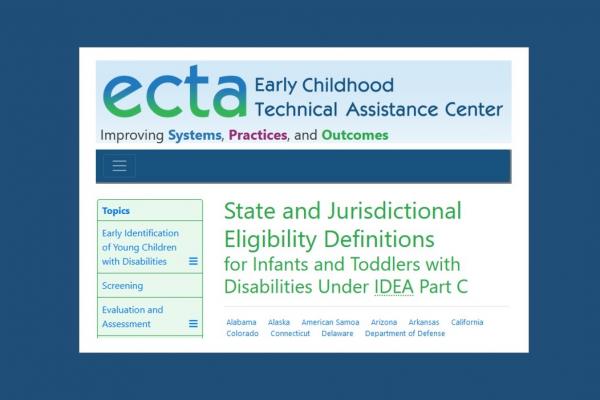
New database provides key information about state and jurisdictional IDEA Part C eligibility policy
According to the Individuals with Disabilities Education Act (IDEA), states and jurisdictions must actively identify, locate, and evaluate children birth to twenty-one who may have disabilities or are suspected to have disabilities as early as possible. Infants and toddlers birth through age 2 with disabilities, and their families, receive early intervention services under IDEA Part C.
Part C eligibility is determined by each state's or jurisdiction's definition of an infant or toddler with a disability (34 CFR §303.21) which must include an infant or toddler with a developmental delay and an infant or toddler with diagnosed physical or mental conditions with a high probability of resulting in developmental delay. In addition, states and jurisdictions may choose to serve children at risk for disabilities in their eligibility definition.
Since each state or jurisdiction establishes its own eligibility policy, it can be difficult for researchers, practitioners, and families to locate information. A new database aims to help with that.
“The creation of this database came about from a real need,” says Evelyn Shaw, MEd, a technical assistance specialist at the UNC Frank Porter Graham Child Development Institute (FPG) working with the ECTA Center. In 2006, Jo Shackleford—who at the time was a technical assistance specialist at FPG working in the National Early Childhood Technical Assistance Center (NECTAC)—wrote “State and Jurisdictional Eligibility Definitions for Infants and Toddlers with Disabilities Under IDEA,” which included a table summarizing Part C eligibility policies of states and other governing jurisdictions.
“Jo’s publication included pages of descriptive, useful information,” says Shaw. “It was updated several times until 2011, and then the table itself was produced until March of 2015.” Shaw says that not only were researchers finding the information useful, so were state officials. States looking to change their own eligibility criteria could use it to see other states’ policies. When the person updating the table retired, Shaw decided to take over. With the help of Siobhan Colgan, a former FPG colleague, and Kathryn Morrison from the DaSY Center, they began updating the information from the last publication of the “States’ and territories’ definitions of/criteria for IDEA Part C eligibility” table.
The task was not an easy or quick one. ECTA Center and DaSy Center staff reviewed online documentation of state eligibility policies for 57 U.S. states, territories, and the Department of Defense providing Part C early intervention services. They had to locate and review each state’s eligibility documents, and capture hyperlinks to policies and supplemental materials. Next, they coded data describing the state policies across multiple variables using categorical groups, qualitative coding, and narrative summaries. Once compiled, they shared the summaries of each state’s and jurisdiction’s eligibility information and coding with their corresponding Part C coordinators for verification.
After spending almost two years compiling and verifying the information, the team decided to take a big step—rather than producing another table, why not use all they’d gathered to create a functional database. Cherie Bartell, MIS, an applications analyst at FPG, joined the project and transformed the tracking spreadsheets into a functional online database.
The State and Jurisdictional Eligibility Definitions for Infants and Toddlers with Disabilities Under IDEA Part C Database provides key information about a state's or jurisdiction's eligibility policy, including:
- Definition of developmental delay
- At risk for developmental delay policy (if applicable)
- Link to state eligibility policy and additional links to other policies, if available
- Selected Categories of Diagnosed Conditions (e.g., prematurity, low birth weight, very low birth weight, small for gestational age, prenatal exposure to substances, hearing impairment, vision impairment, prenatal exposure to Zika) are included if information is available beyond Part C regulatory language.
In January, Shaw and Morrison discussed the project during a poster presentation at the Division for Early Childhood (DEC) Conference. Following the conference and the launch of the database, they’ve received many messages of praise, including one from a state coordinator, who shared, “I’m glad this information is being updated. It’s a great way for states to compare ourselves to others.”
Right now, the database is updated on a rolling basis as states submit requests to Shaw. They will also conduct a full review of the database and seek verification from state coordinators at least once per year.
When asked about the future of the database, Shaw replied, “We are looking at ways to make more of the data in the database available on the website. For example, we could share details on certain diagnosed conditions that we would summarize and present via graphs and charts.”
